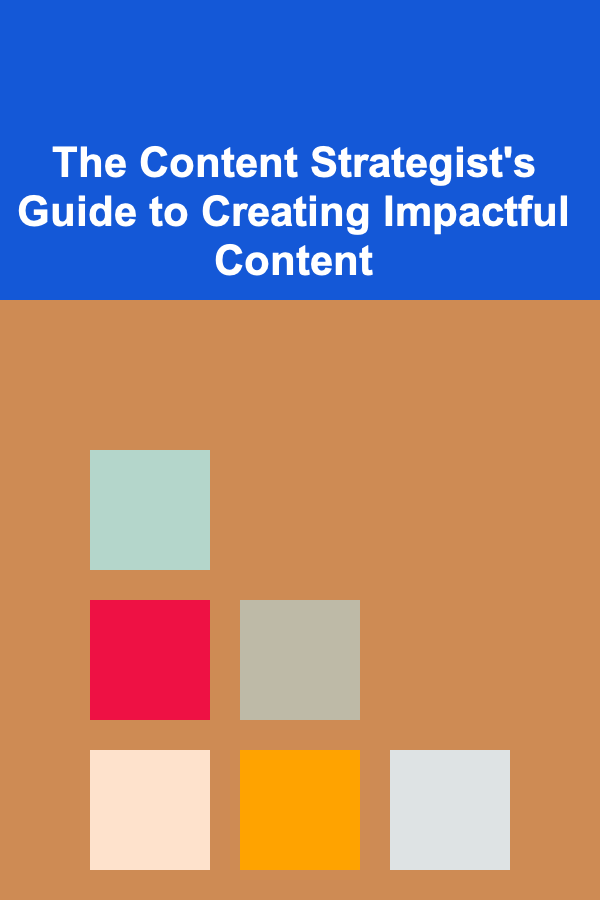
The Content Strategist's Guide to Creating Impactful Content
ebook include PDF & Audio bundle (Micro Guide)
$12.99$10.99
Limited Time Offer! Order within the next:

Creating impactful content is the foundation of successful digital marketing and brand engagement. As a content strategist, your role goes far beyond simply writing blog posts or producing social media updates. It involves understanding your audience, crafting compelling narratives, and using the right platforms to ensure your content resonates deeply with the target market. This guide explores actionable strategies that will help you develop a robust content strategy, produce high-quality content, and ultimately drive meaningful results.
Understanding Your Audience
Creating impactful content starts with a thorough understanding of your audience. Without insight into their needs, pain points, and motivations, your content is likely to miss the mark. The more precisely you can target your content to specific segments of your audience, the greater the impact.
Create Detailed Buyer Personas
A buyer persona is a semi-fictional representation of your ideal customer. These personas are based on data about your current customers and target audience, and they should include:
- Demographic information (age, gender, location, etc.)
- Psychographics (interests, values, behaviors, etc.)
- Pain points and challenges they are facing
- Preferred content formats (blogs, videos, infographics, etc.)
- Where they consume content and how they make purchasing decisions
Actionable Tip: Use tools like Google Analytics, social media insights, and surveys to gather data that can inform your buyer personas. Make sure your content is tailored to address their specific needs and preferences.
Conduct Regular Audience Research
Even after developing buyer personas, your audience's preferences and behaviors can change over time. Regular research is essential to stay updated and make adjustments to your strategy. This can be achieved through:
- Surveys and polls on social media or via email
- User interviews and focus groups
- Tracking customer feedback and comments
- Monitoring audience behavior through analytics tools
Actionable Tip: Set up a routine to review your audience data on a monthly or quarterly basis. Tools like Hotjar or Qualaroo can help you gather qualitative data, while Google Analytics or HubSpot provide quantitative insights.
Setting Clear and Measurable Objectives
Before creating content, define your objectives. Without clear goals, your content efforts can become scattered, leading to low engagement or irrelevant messaging. Effective content strategies align with business objectives and focus on driving tangible results.
Align Content Goals with Business KPIs
For content to truly make an impact, it needs to support the business's key performance indicators (KPIs). Some common content goals include:
- Lead generation: Creating content that captures leads, such as gated resources, landing pages, or email sign-ups.
- Brand awareness: Publishing content that introduces your brand to new audiences and expands your reach.
- Customer retention and loyalty: Developing content that keeps existing customers engaged and strengthens brand loyalty.
- Sales conversion: Producing content that directly supports the sales funnel by nurturing leads into conversions.
Actionable Tip: Work with other departments (sales, product, customer support) to ensure your content aligns with broader company objectives. Use SMART goals (Specific, Measurable, Achievable, Relevant, Time-bound) to ensure your content strategy is actionable and trackable.
Measure Success with the Right Metrics
To determine if your content is truly impactful, track relevant metrics:
- Engagement metrics such as likes, shares, comments, and time on page.
- SEO performance like organic traffic, keyword rankings, and backlinks.
- Lead generation metrics like email sign-ups, form submissions, and webinar registrations.
- Conversion metrics such as sales, revenue, and customer lifetime value (CLV).
Actionable Tip: Use tools like Google Analytics, HubSpot, or SEMrush to track these metrics. Regularly review your content performance to identify areas for improvement and optimize your approach.
Creating High-Quality, Valuable Content
The quality of your content is non-negotiable. It's not just about frequency or volume; it's about delivering value to your audience. Quality content addresses the needs and challenges of your audience while establishing your brand as an authority.
Focus on Providing Value Over Promotion
The most successful content strategies provide value rather than constantly pushing for a sale. Instead of focusing solely on your product or service, educate your audience, answer their questions, and provide insights that help them make informed decisions.
Actionable Tip: Shift the focus from promotional content to educational content. Create how-to guides, case studies, and thought leadership pieces that showcase your expertise and help your audience solve real-world problems.
Diversify Your Content Formats
Different people consume content in different ways. Some prefer long-form blog posts, while others prefer videos, podcasts, or infographics. As a content strategist, it's important to diversify the formats you use to reach a wider audience and cater to different preferences.
Actionable Tip: Develop a content calendar that includes a mix of content types. For example:
- Blog posts: In-depth articles that tackle industry trends or provide expert advice.
- Videos: Tutorials, behind-the-scenes looks, or thought leadership content.
- Podcasts: Interviews with experts, customer stories, or industry discussions.
- Infographics: Data-driven visual content to explain complex ideas in a digestible format.
Craft Compelling Headlines and Introductions
The headline and introduction are your first and only chance to capture your audience's attention. Without a strong hook, even the most insightful content can be overlooked.
Actionable Tip: Use emotional triggers in your headlines, such as urgency, curiosity, or exclusivity. Keep them clear and concise, and always promise a benefit to the reader. Test different headline formats to see what resonates best with your audience.
Optimizing for Search Engines (SEO)
To ensure your content reaches the right audience, it's crucial to optimize it for search engines. SEO (Search Engine Optimization) ensures that your content is discoverable and ranks well on search engines like Google.
Conduct Keyword Research
Keyword research helps you understand what terms and phrases your target audience is searching for. It provides insight into the language they use and the questions they want answered.
Actionable Tip: Use keyword research tools like Google Keyword Planner, Ahrefs, or Ubersuggest to identify high-volume, low-competition keywords. Incorporate these keywords naturally into your content, especially in headings, subheadings, and the first 100 words.
Optimize On-Page SEO
Once you have the right keywords, make sure your content is optimized for both users and search engines. This includes:
- Using keywords in title tags, meta descriptions, and URL slugs.
- Including internal links to other related content on your website.
- Optimizing images with alt text and ensuring fast load times.
- Using header tags (H1, H2, H3) to structure your content for readability.
Actionable Tip: Aim for a content-to-keyword density of 1-2%, but avoid keyword stuffing. Focus on natural language and user experience. Tools like Yoast SEO for WordPress can help guide you in the optimization process.
Create Link-Worthy Content
Building backlinks is crucial for SEO. The more high-quality, authoritative websites that link back to your content, the higher it will rank on search engines.
Actionable Tip: Develop "linkable" content, such as original research, comprehensive guides, and data-driven case studies, that others in your industry will want to reference. Reach out to influencers or publications for backlinks.
Distributing Your Content Across the Right Channels
Creating content is only half the battle---distribution is where the magic happens. Even the best content can go unnoticed if it's not shared with the right audience through the right channels.
Choose the Right Distribution Channels
To amplify the impact of your content, distribute it across platforms where your target audience is most active. This could include:
- Your website and blog for organic traffic.
- Social media platforms (Facebook, Twitter, LinkedIn, Instagram) for engagement and visibility.
- Email marketing to nurture leads and share personalized content.
- Paid media (Google Ads, Facebook Ads) to promote high-converting content.
Actionable Tip: Tailor your content distribution to the preferences of your audience. For instance, LinkedIn is ideal for B2B content, while Instagram is better suited for visually appealing, consumer-facing content. Schedule posts at optimal times for engagement.
Repurpose Content for Multiple Channels
To maximize the value of each piece of content, repurpose it across various channels. For example:
- Turn a blog post into a video or infographic.
- Break down a long-form article into a series of social media posts.
- Summarize key points from a podcast in a blog post or LinkedIn article.
Actionable Tip: Use a content repurposing strategy to ensure that each piece of content is getting the exposure it deserves across multiple touchpoints. Tools like Buffer or Hootsuite can help schedule and automate your posts.
Conclusion
Creating impactful content is a strategic and ongoing process that requires a deep understanding of your audience, clear objectives, high-quality content, effective SEO practices, and a robust distribution plan. As a content strategist, your role is to guide the creation, optimization, and distribution of content that drives real business results. By focusing on these actionable strategies and continuously refining your approach, you can create content that not only engages but also converts and builds long-term brand loyalty.
Reading More From Our Other Websites
- [Home Maintenance 101] How to Deep Clean Your Kitchen Appliances
- [Gardening 101] Designing a Colorful Fall Garden: Ideas for Every Yard
- [Home Soundproofing 101] How to Soundproof Your Room by Enhancing Existing Walls
- [Personal Financial Planning 101] How to Manage Your Finances During Major Life Changes
- [Skydiving Tip 101] Comparing the Top Indoor Wind Tunnels Worldwide: Features, Costs, and Unique Attractions
- [Organization Tip 101] How to Develop a Daily Routine for Office Organization
- [Personal Financial Planning 101] How to Pay Off Student Loans Faster: Tips and Strategies
- [Home Budget 101] How to Create a Realistic Home Budget
- [Home Budget Decorating 101] How to Upcycle Household Items into Decorative Pieces
- [Beachcombing Tip 101] Photography Hotspots: The Most Photogenic Features to Hunt Down on Any Beach

How to Calculate International Shipping Costs for Your Dropshipping Store
Read More
How to Create a Checklist for Preparing Your Car for Emergencies
Read More
How to Sell Homemade Products Online and Earn Extra Income
Read More
How to Promote Wildlife-Friendly Resorts
Read More
Understanding the Genetics of Psychiatric Disorders: A Deep Dive
Read More
Glass Blowing for Jewelry: A Beginner's Project
Read MoreOther Products

How to Calculate International Shipping Costs for Your Dropshipping Store
Read More
How to Create a Checklist for Preparing Your Car for Emergencies
Read More
How to Sell Homemade Products Online and Earn Extra Income
Read More
How to Promote Wildlife-Friendly Resorts
Read More
Understanding the Genetics of Psychiatric Disorders: A Deep Dive
Read More